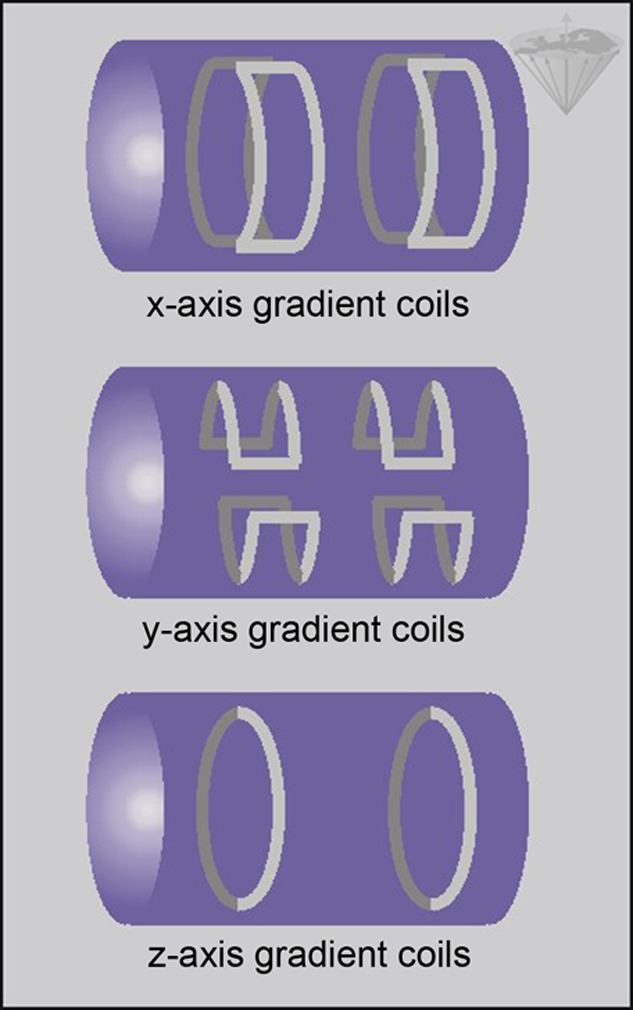





 agnetic field gradients are necessary to create MR images. The reasons for this will be explained in detail in Chapter 6.
agnetic field gradients are necessary to create MR images. The reasons for this will be explained in detail in Chapter 6.
Two wires with electric current moving in the opposite direction can create a linear change of the magnetic field between each other when placed at the correct distance (see Figure 01-04). This is also known as a magnetic field gradient.
Three sets of gradient coils are necessary to be able to create a weak magnetic field in any direction in space (Figure 03-10). With mid- and high-field systems, the strength of the magnetic field created by gradient coils is approximately 100 times lower than the main field. The coils are actively shielded.

Figure 03-10:
Schematic depiction of gradient coils in a superconducting or resistive magnet system. To cover all three spatial dimensions (x, y, and z), three sets of gradient coils are installed in the bore of the MR machine. By changing the current flow relative to each other, planes in any direction can be laid through the patient's body.
The performance of gradients coils is measured in mT/m, their peak amplitudes. Common peak amplitudes at low and medium fields are 10 mT/m; to avoid chemical shift artifacts, high-field 1.5 T systems require between 30 and 45 mT/m. At 3.0 Tesla the peak gradient strength can reach 80 mT/m.
A second important property of gradients is their rise time (ms) or slew rate (T/m/s). The faster the rise time or the higher the slew rate, the better the system performance will be, i.e., the faster image data can be acquired. Slew rates at low and medium field are between 50 and 120 T/m/s, at 1.5 T between 150 and 200 T/m/s.
Owing to adverse effects such as mechanical vibrations and considerable noise on ultrahigh field systems, the slew rate has to be curbed; common slew rates at 3.0 Tesla are similar to those of 1.5 Tesla; in 7.0 Tesla research machines, the slew rates are between 70 and 80 T/m/s.
Noise. Since the gradient coils are inside the strong magnetic field of the MR equipment, rapidly changing currents within the gradient coils give rise to powerful Lorentz forces that cause acoustic noise, mostly knocking sounds. At low and medium fields, this noise is tolerable for the patient and the environment, at 1.5 Tesla it is unpleasant, at ultrahigh fields intolerable without ear protection.
Different pulse sequences produce louder or less loud noises; special, adapted pulse sequences can lower the noise at high and ultrahigh fields; enclosing the gradients in a vacuum chamber and separating them from the magnet structure may also remedy the problem to a certain extent.
Because of the vibrations and the noise, preterm and term infants must not be examined at ultrahigh fields [⇒ Tkach 2014].
These currents, also called Foucault currents, are introduced by the gradients’ time varying magnetic field.
They can both degrade the homogeneity of the static magnetic field as well as distort the gradient pulse profiles. If they are not compensated for, image quality will significantly decrease. One way to counteract their influence is by shielding the gradient so that their fields are restricted to the interior of the patient bore.